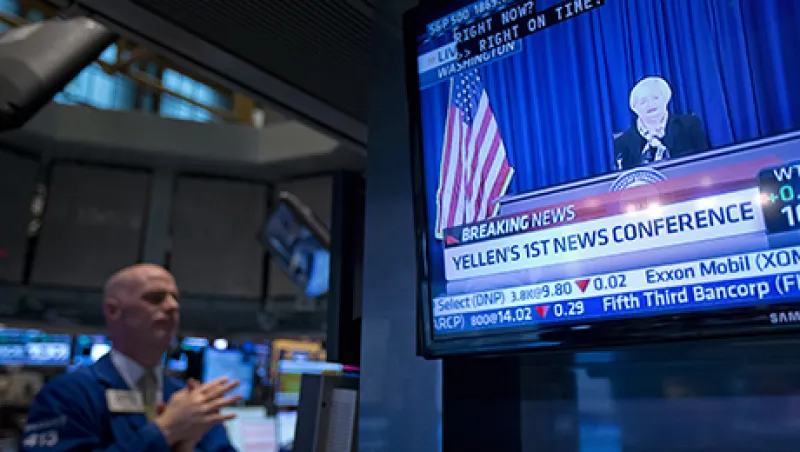Some 30 years ago, as Martin Fridson was compiling a high-yield-bond research publication at Morgan Stanley, he asked an analyst who had written a report on Time Warner to add photos of an entertainer to lend some visual appeal to the report. He got some truly eye-catching content.
“The picture was of Madonna, who was just emerging,” Fridson remembers. “I said, ‘It looks like she has her clothes on.’ When we saw the photo in print, she was in her underwear. Morgan Stanley was pretty straitlaced. Fortunately, portfolio managers — who at the time were almost exclusively male — loved it, so any apparent misstep was forgiven.”
Weeks later, Madonna appeared on the covers of Time and Newsweek. Fridson muses, “I thought we scooped them.” Now, more than halfway into 2014, the daughter of the Queen of Pop is gearing up to start her freshman year at the University of Michigan at Ann Arbor. And Fridson, 61, whom Institutional Investor has dubbed “the dean of high-yield-bond analysts” and named nine straight times to the top of the All-America Fixed-Income Research Team through 2002, is still ahead of the curve — yield or otherwise. According to the bond analyst, the present high-yield bond market bears more than a passing resemblance to that of 1981, when he started with Salomon Brothers and was focusing mainly on credit research, with an angle toward high-yield debt, then a burgeoning asset class among institutional investors.
The common thread is overcomplacency, says Fridson, now chief investment officer at Lehmann, Livian, Fridson Advisors, a New York and Miami–based money management firm approved by the Securities and Exchange Commission in April. As in 1981, the present default rate is low: a 2.1 percent annual rate for the year through May, according to Moody’s Investors Service. The long-run average is 4.5 percent. The subdued default rate is feeding the complacency, he says.
But a low default rate offers no guarantee that high-yield bonds won’t drop in the future, any more than it did in 1981, he warns, noting that bond prices often fall well in advance of defaults. “Bonds that defaulted in 2008 went from par to 70 during 2007,” he notes. “People don’t grasp that bonds that default already are at distressed levels in the year before they default.” Fridson defines “distressed” as any bond yielding 10 or more percentage points greater than comparable U.S. Treasuries.
The default rate could remain low next year. Moody’s forecasts a rate of 2.5 percent over the next 12 months. But, says Fridson, the number of bonds trading at distressed levels could rise. Currently, the distress rate is under 4 percent — very low by historical standards. That rate, however, could jump to double digits by the end of 2015, he says. “High-yield bonds could wind up with a negative return in 2015, without the default rate going up at all.”
Playing into Fridson’s forecast is his assessment that high-yield bonds are, as he puts it, “very much” overvalued. The average spread of high-yield bonds over Treasuries was 357 basis points as of July 14, compared with Fridson’s fair-value estimate of 541 basis points. “It’s not the greatest overvaluation of all time, but that’s about as extreme as it gets,” he says.
To be sure, Fridson doesn’t see high-yield bonds in a bubble.
“What people usually have in mind for a bubble is the Greater Fool Theory,” he explains: “‘Yes, assets may be overpriced, but I need to buy anyway because other people will pay more and I have to get in before I miss the opportunity.’” That is definitely not the case with high-yield bonds today, he points out, because money managers aren’t wildly chasing the market.
One other difference from the era of big hair, when Fridson got his start, is the sheer quantity of sell-side research on the high-yield sector today. Back then the market was called junk, but Fridson’s research helped establish the legitimacy of high-yield bonds as a major asset class.
“There wasn’t really anyone else talking about high-yield in terms of, ‘Does the asset class make sense?’” says David Sherman, principal of investment firm Cohanzick Management in Pleasantville, New York, who was Fridson’s client in the early 1990s when he worked for New York–headquartered holding company Leucadia National Corp. “He was one of the early innovators, a pioneer in that respect.”
So what else has changed in the high-yield market during his 30-plus-year career? Hedge funds have become major players in the market. They didn’t participate much until 2000, Fridson says, but “now they are more active traders than other investors.” Also, covenants have strengthened, and the market has become much more global. “Even China has high-yield bonds,” he notes.
Fridson left Salomon Brothers for Morgan Stanley in 1984 to pursue the “opportunity to do basic research on how the high-yield market worked” as head of corporate-bond research, he recalls. “There hadn’t been detailed research before. That’s what really put me on the map.” Five years later, when he moved to Merrill Lynch in 1989, “the credibility of sell-side research on high-yield was abysmally low, and for good reason: Analysts weren’t objective,” Fridson says. He stayed at Merrill until 2002 as the chief high-yield strategist, where he racked up his II ranking accolades.
As for Fridson’s own personal bond rating, Sherman and Jeffrey Bersh, co–chief investment officer of New York registered investment adviser Venor Capital, agree that Fridson in no way fits the cutthroat, money-obsessed stereotype of Wall Street. “He’s definitely driven by a different set of motivations than many on Wall Street,” says Bersh, who worked for Fridson in the early 1990s. “He just wants to find the truth about the market, and he is very good at doing that.”
Get more on fixed income.







